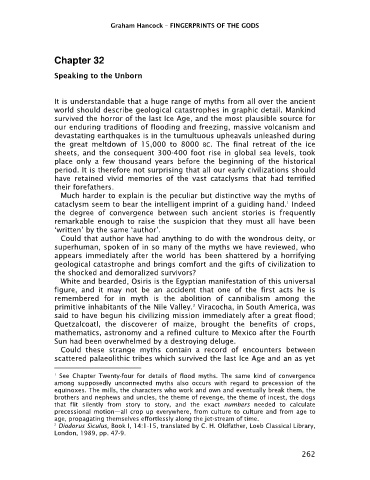Page 264 - Fingerprints of the Gods by Graham Hancock
P. 264
Graham Hancock – FINGERPRINTS OF THE GODS
Chapter 32
Speaking to the Unborn
It is understandable that a huge range of myths from all over the ancient
world should describe geological catastrophes in graphic detail. Mankind
survived the horror of the last Ice Age, and the most plausible source for
our enduring traditions of flooding and freezing, massive volcanism and
devastating earthquakes is in the tumultuous upheavals unleashed during
the great meltdown of 15,000 to 8000 BC. The final retreat of the ice
sheets, and the consequent 300-400 foot rise in global sea levels, took
place only a few thousand years before the beginning of the historical
period. It is therefore not surprising that all our early civilizations should
have retained vivid memories of the vast cataclysms that had terrified
their forefathers.
Much harder to explain is the peculiar but distinctive way the myths of
cataclysm seem to bear the intelligent imprint of a guiding hand. Indeed
1
the degree of convergence between such ancient stories is frequently
remarkable enough to raise the suspicion that they must all have been
‘written’ by the same ‘author’.
Could that author have had anything to do with the wondrous deity, or
superhuman, spoken of in so many of the myths we have reviewed, who
appears immediately after the world has been shattered by a horrifying
geological catastrophe and brings comfort and the gifts of civilization to
the shocked and demoralized survivors?
White and bearded, Osiris is the Egyptian manifestation of this universal
figure, and it may not be an accident that one of the first acts he is
remembered for in myth is the abolition of cannibalism among the
primitive inhabitants of the Nile Valley. Viracocha, in South America, was
2
said to have begun his civilizing mission immediately after a great flood;
Quetzalcoatl, the discoverer of maize, brought the benefits of crops,
mathematics, astronomy and a refined culture to Mexico after the Fourth
Sun had been overwhelmed by a destroying deluge.
Could these strange myths contain a record of encounters between
scattered palaeolithic tribes which survived the last Ice Age and an as yet
1 See Chapter Twenty-four for details of flood myths. The same kind of convergence
among supposedly unconnected myths also occurs with regard to precession of the
equinoxes. The mills, the characters who work and own and eventually break them, the
brothers and nephews and uncles, the theme of revenge, the theme of incest, the dogs
that flit silently from story to story, and the exact numbers needed to calculate
precessional motion—all crop up everywhere, from culture to culture and from age to
age, propagating themselves effortlessly along the jet-stream of time.
2 Diodorus Siculus, Book I, 14:1-15, translated by C. H. Oldfather, Loeb Classical Library,
London, 1989, pp. 47-9.
262

